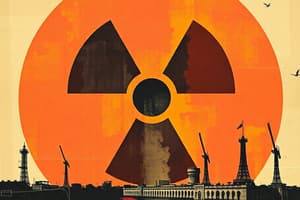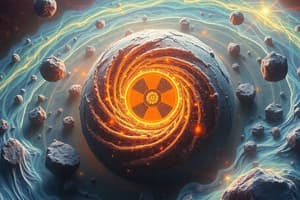Podcast
Questions and Answers
What is the process called when a neutron in a nucleus converts into a proton and emits an electron and antineutrino?
What is the process called when a neutron in a nucleus converts into a proton and emits an electron and antineutrino?
- β− decay (correct)
- β+ decay
- Proton emission
- Electron capture
What type of decay occurs when a proton in a nucleus converts into a neutron and emits a positron and a neutrino?
What type of decay occurs when a proton in a nucleus converts into a neutron and emits a positron and a neutrino?
- Proton emission
- β− decay
- β+ decay (correct)
- Electron capture
What is the process called when a nucleus emits a neutron directly?
What is the process called when a nucleus emits a neutron directly?
- Proton emission
- Neutron emission (correct)
- Electron capture
- β− decay
What type of decay occurs when a nucleus captures an orbital electron and converts a proton into a neutron, emitting a neutrino?
What type of decay occurs when a nucleus captures an orbital electron and converts a proton into a neutron, emitting a neutrino?
What is the result of a nucleus having a low N/Z ratio?
What is the result of a nucleus having a low N/Z ratio?
What is the result of a nucleus emitting a proton directly?
What is the result of a nucleus emitting a proton directly?
What type of decay has a competing process to β− decay?
What type of decay has a competing process to β− decay?
What is the change in atomic mass number A in neutron emission decay?
What is the change in atomic mass number A in neutron emission decay?
What type of radiolabels are used for positron emission tomography (PET)?
What type of radiolabels are used for positron emission tomography (PET)?
What is the half-life of lithium-5 decaying into helium-4 through proton emission?
What is the half-life of lithium-5 decaying into helium-4 through proton emission?
What occurs when a proton is emitted from a nucleus?
What occurs when a proton is emitted from a nucleus?
What is the half-life of helium-5 decaying into helium-4 through neutron emission?
What is the half-life of helium-5 decaying into helium-4 through neutron emission?
What is the effect on atomic number Z and atomic mass number A in proton emission decay?
What is the effect on atomic number Z and atomic mass number A in proton emission decay?
What type of decay is more common than proton emission decay?
What type of decay is more common than proton emission decay?
What is the effect on the number of neutrons in proton emission decay?
What is the effect on the number of neutrons in proton emission decay?
What is the term for the emission of an electron from the outermost shell of an atom?
What is the term for the emission of an electron from the outermost shell of an atom?
What is the effect on the stability of a nucleus in proton emission decay?
What is the effect on the stability of a nucleus in proton emission decay?
What type of nuclides are likely to undergo proton emission decay?
What type of nuclides are likely to undergo proton emission decay?
What is the primary reason for the unstability of a nucleus with a low N/Z ratio?
What is the primary reason for the unstability of a nucleus with a low N/Z ratio?
Which of the following nuclei is likely to be stable?
Which of the following nuclei is likely to be stable?
What is the main factor that determines the type of decay process a radionuclide will undergo?
What is the main factor that determines the type of decay process a radionuclide will undergo?
What is the result of a nucleus having a high N/Z ratio?
What is the result of a nucleus having a high N/Z ratio?
Which of the following nuclei is most likely to undergo a decay process?
Which of the following nuclei is most likely to undergo a decay process?
What type of decay competes with α decay in very large atomic mass number nuclides?
What type of decay competes with α decay in very large atomic mass number nuclides?
What type of radiopharmaceutical decay is characterized by the emission of pure gamma rays with no subsequent change in the nucleus?
What type of radiopharmaceutical decay is characterized by the emission of pure gamma rays with no subsequent change in the nucleus?
What type of decay results in a transformation of a neutron into a proton?
What type of decay results in a transformation of a neutron into a proton?
What type of nuclides are likely to undergo β decay?
What type of nuclides are likely to undergo β decay?
What is a characteristic of an ideal radiopharmaceutical in terms of its physical half-life?
What is a characteristic of an ideal radiopharmaceutical in terms of its physical half-life?
What is the primary limitation on the creation of new elements with high atomic numbers?
What is the primary limitation on the creation of new elements with high atomic numbers?
Which type of decay is most likely to occur in very proton-rich nuclides?
Which type of decay is most likely to occur in very proton-rich nuclides?
What is the result of spontaneous fission in terms of atomic number and atomic mass number?
What is the result of spontaneous fission in terms of atomic number and atomic mass number?
Which type of decay is a competing process to alpha decay in terms of nuclear stability?
Which type of decay is a competing process to alpha decay in terms of nuclear stability?
What is the relationship between the parent and daughter nuclides in proton emission decay?
What is the relationship between the parent and daughter nuclides in proton emission decay?
What is an ideal characteristic of a radiopharmaceutical?
What is an ideal characteristic of a radiopharmaceutical?
What occurs when a nucleus emits a gamma ray?
What occurs when a nucleus emits a gamma ray?
Which isotope is more likely to be radioactive?
Which isotope is more likely to be radioactive?
What is a desirable property of a radiopharmaceutical?
What is a desirable property of a radiopharmaceutical?
What is a characteristic of an ideal radiopharmaceutical?
What is a characteristic of an ideal radiopharmaceutical?
What is the condition required for beta decay to occur?
What is the condition required for beta decay to occur?
What is the purpose of using radionuclides decaying by β− decay in medicine?
What is the purpose of using radionuclides decaying by β− decay in medicine?
What is the outcome of the decay of an unstable daughter nucleus formed through beta decay?
What is the outcome of the decay of an unstable daughter nucleus formed through beta decay?
Which of the following radionuclides is commonly used for radiotherapy?
Which of the following radionuclides is commonly used for radiotherapy?
What occurs when a parent nucleus undergoes beta decay?
What occurs when a parent nucleus undergoes beta decay?
What is the fate of the excited daughter nucleus formed through beta decay?
What is the fate of the excited daughter nucleus formed through beta decay?
Why is beta decay possible in certain nuclei?
Why is beta decay possible in certain nuclei?
What is the half-life of cobalt 60?
What is the half-life of cobalt 60?
What is the outcome of beta decay in medicine?
What is the outcome of beta decay in medicine?
What is the process involved in the decay of an unstable daughter nucleus formed through beta decay?
What is the process involved in the decay of an unstable daughter nucleus formed through beta decay?
What is the primary reason for radioactive decay in unstable nuclei?
What is the primary reason for radioactive decay in unstable nuclei?
Which type of decay involves the emission of heavier nuclei?
Which type of decay involves the emission of heavier nuclei?
What is the characteristic of a nucleus with a high N/Z ratio?
What is the characteristic of a nucleus with a high N/Z ratio?
Which type of decay involves the emission of α particles?
Which type of decay involves the emission of α particles?
What is the general trend for N/Z in low atomic number elements?
What is the general trend for N/Z in low atomic number elements?
What is the result of a nucleus having an extremely high N/Z ratio?
What is the result of a nucleus having an extremely high N/Z ratio?
What is the characteristic of the α-particle emitted in α decay?
What is the characteristic of the α-particle emitted in α decay?
What is the result of β+ decay in a nucleus?
What is the result of β+ decay in a nucleus?
What is the difference between β− decay and electron capture?
What is the difference between β− decay and electron capture?
What is the result of a nucleus having a low N/Z ratio?
What is the result of a nucleus having a low N/Z ratio?
Above which nucleon number A does a stable nucleus typically require more neutrons than protons?
Above which nucleon number A does a stable nucleus typically require more neutrons than protons?
What is the primary reason for the instability of an atomic nucleus?
What is the primary reason for the instability of an atomic nucleus?
Which type of decay involves the emission of a positron and a neutrino?
Which type of decay involves the emission of a positron and a neutrino?
What is the result of a nucleus emitting an alpha particle?
What is the result of a nucleus emitting an alpha particle?
What is the characteristic of a nucleus with a high N/Z ratio?
What is the characteristic of a nucleus with a high N/Z ratio?
For which nuclides is spontaneous fission a possible decay process?
For which nuclides is spontaneous fission a possible decay process?
What is the result of proton emission decay in terms of atomic number?
What is the result of proton emission decay in terms of atomic number?
Which type of decay is characterized by the emission of alpha particles?
Which type of decay is characterized by the emission of alpha particles?
What is the transformation that occurs in β- decay?
What is the transformation that occurs in β- decay?
What is the result of a slight imbalance in the number of protons and neutrons in a nucleus?
What is the result of a slight imbalance in the number of protons and neutrons in a nucleus?
What is a characteristic of a nucleus with a high N/Z ratio?
What is a characteristic of a nucleus with a high N/Z ratio?
What type of decay involves the emission of a positron and a neutrino?
What type of decay involves the emission of a positron and a neutrino?
What is the competing process to alpha decay in terms of nuclear stability?
What is the competing process to alpha decay in terms of nuclear stability?
What occurs when a nucleus emits a gamma ray?
What occurs when a nucleus emits a gamma ray?
Which type of decay is more likely to occur in very proton-rich nuclides?
Which type of decay is more likely to occur in very proton-rich nuclides?
What is the outcome of spontaneous fission in terms of atomic number and atomic mass number?
What is the outcome of spontaneous fission in terms of atomic number and atomic mass number?
In which type of decay does a proton change into a neutron, emitting a positron and a neutrino?
In which type of decay does a proton change into a neutron, emitting a positron and a neutrino?
What is the result of alpha decay in terms of the nucleus?
What is the result of alpha decay in terms of the nucleus?
What is the primary reason for the instability of a nucleus with a high N/Z ratio?
What is the primary reason for the instability of a nucleus with a high N/Z ratio?
What is the outcome of proton emission decay in terms of the nucleus?
What is the outcome of proton emission decay in terms of the nucleus?
What is the effect of spontaneous fission on the half-life of a nucleus with a high atomic mass number?
What is the effect of spontaneous fission on the half-life of a nucleus with a high atomic mass number?
What occurs when a proton is emitted from a radionuclide in proton emission decay?
What occurs when a proton is emitted from a radionuclide in proton emission decay?
Which type of decay is a competing process to alpha decay in very large atomic mass number nuclides?
Which type of decay is a competing process to alpha decay in very large atomic mass number nuclides?
What is the result of proton emission decay in terms of the parent and daughter nuclei?
What is the result of proton emission decay in terms of the parent and daughter nuclei?
What is the primary limitation on the creation of new elements with high atomic numbers?
What is the primary limitation on the creation of new elements with high atomic numbers?
What is the result of a nucleus having a high N/Z ratio in terms of stability?
What is the result of a nucleus having a high N/Z ratio in terms of stability?
Which type of decay conserves the number of protons and neutrons?
Which type of decay conserves the number of protons and neutrons?
What is the outcome of a direct emission of a neutron from a nucleus?
What is the outcome of a direct emission of a neutron from a nucleus?
What is the process involved in β− decay?
What is the process involved in β− decay?
What is the result of a nucleus having an extremely low N/Z ratio?
What is the result of a nucleus having an extremely low N/Z ratio?
What is the primary condition for β decay to occur in a nucleus?
What is the primary condition for β decay to occur in a nucleus?
What is the outcome of β− decay in medicine?
What is the outcome of β− decay in medicine?
What is the characteristic of the cobalt 60 radionuclide used in radiotherapy?
What is the characteristic of the cobalt 60 radionuclide used in radiotherapy?
What is the fate of the excited daughter nucleus formed through beta decay?
What is the fate of the excited daughter nucleus formed through beta decay?
What is the competing process to β− decay in terms of nuclear stability?
What is the competing process to β− decay in terms of nuclear stability?
What is the result of a nucleus having a high N/Z ratio?
What is the result of a nucleus having a high N/Z ratio?
What is the process called when a nucleus captures an orbital electron and converts a proton into a neutron, emitting a neutrino?
What is the process called when a nucleus captures an orbital electron and converts a proton into a neutron, emitting a neutrino?
What is the characteristic of a nucleus with a low N/Z ratio?
What is the characteristic of a nucleus with a low N/Z ratio?
What is the primary reason for the instability of an atomic nucleus?
What is the primary reason for the instability of an atomic nucleus?
What is the process called when a proton in a nucleus converts into a neutron and emits a positron and a neutrino?
What is the process called when a proton in a nucleus converts into a neutron and emits a positron and a neutrino?
Flashcards are hidden until you start studying




